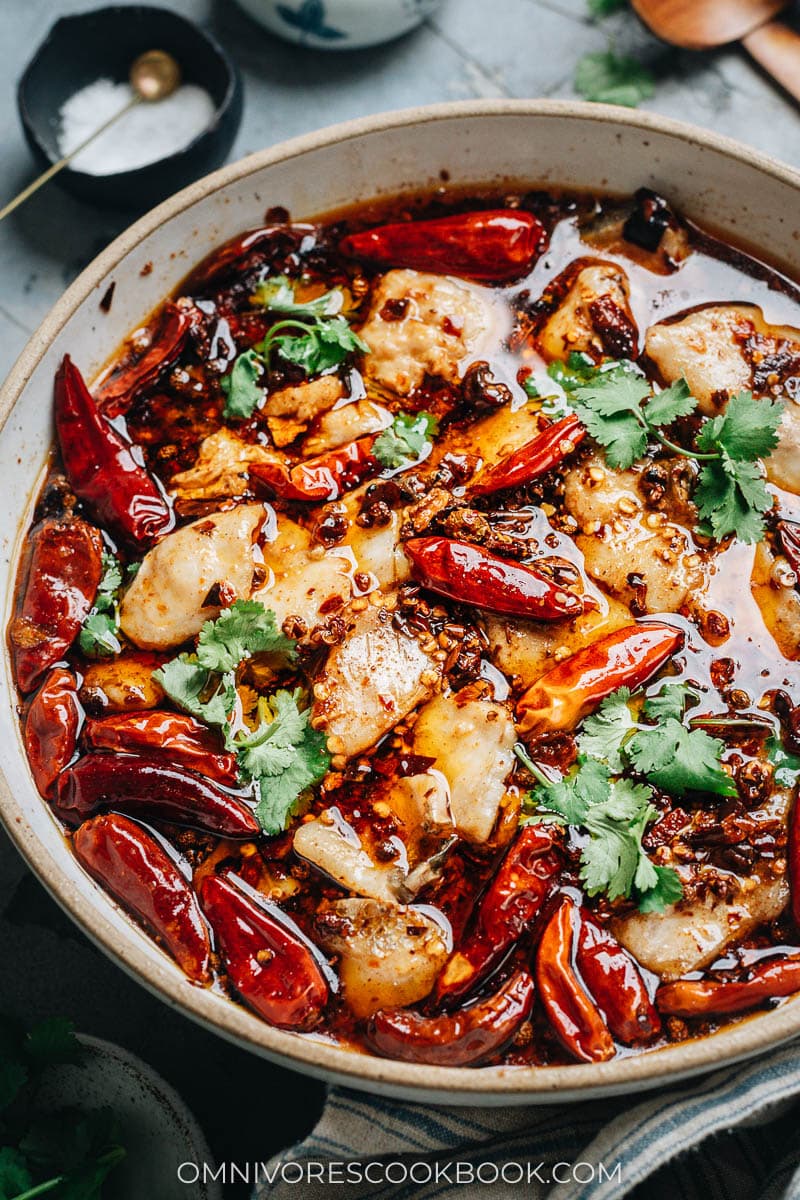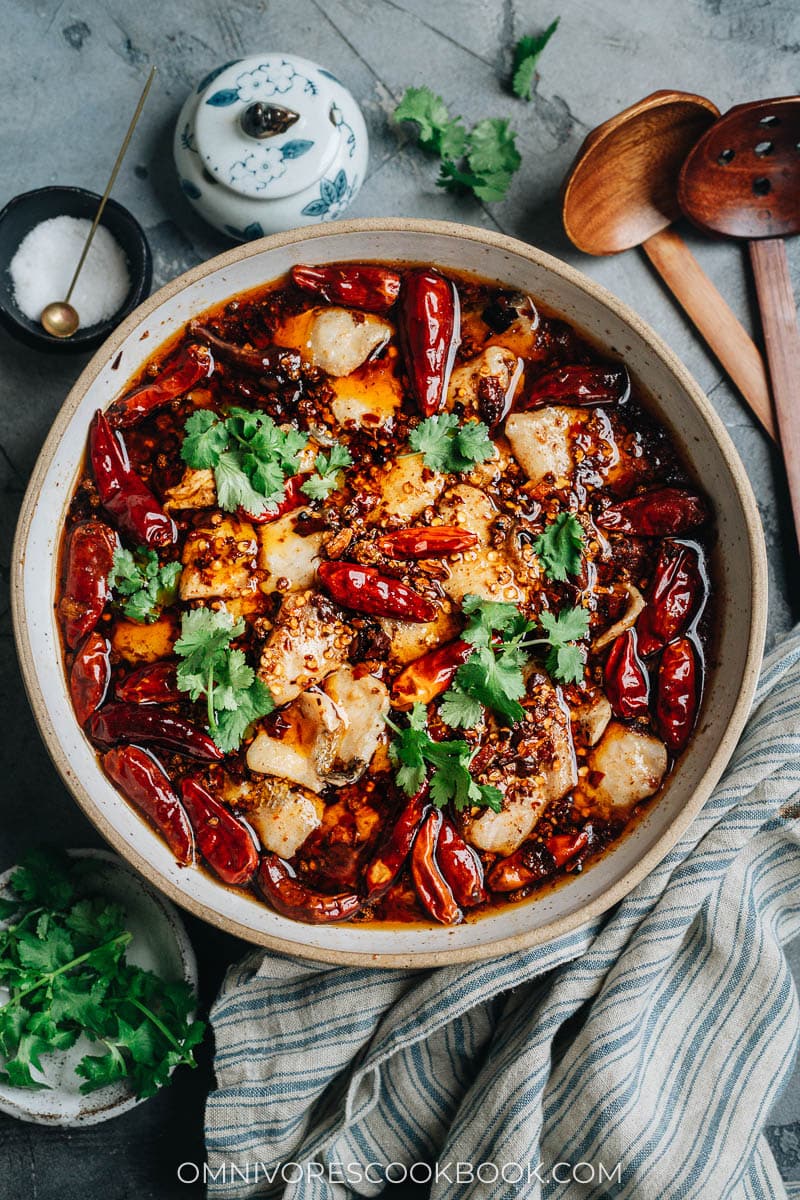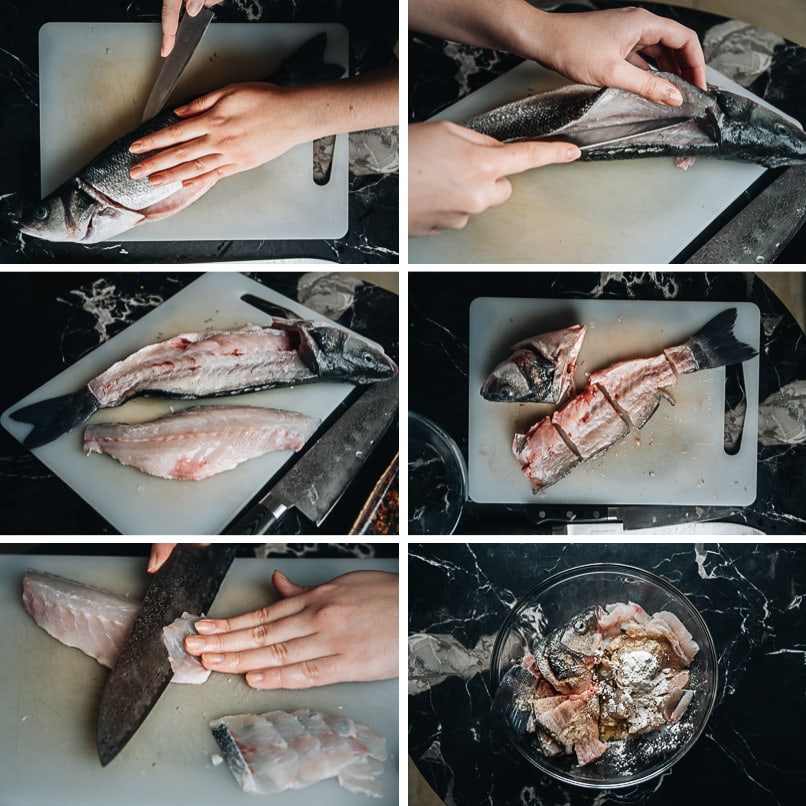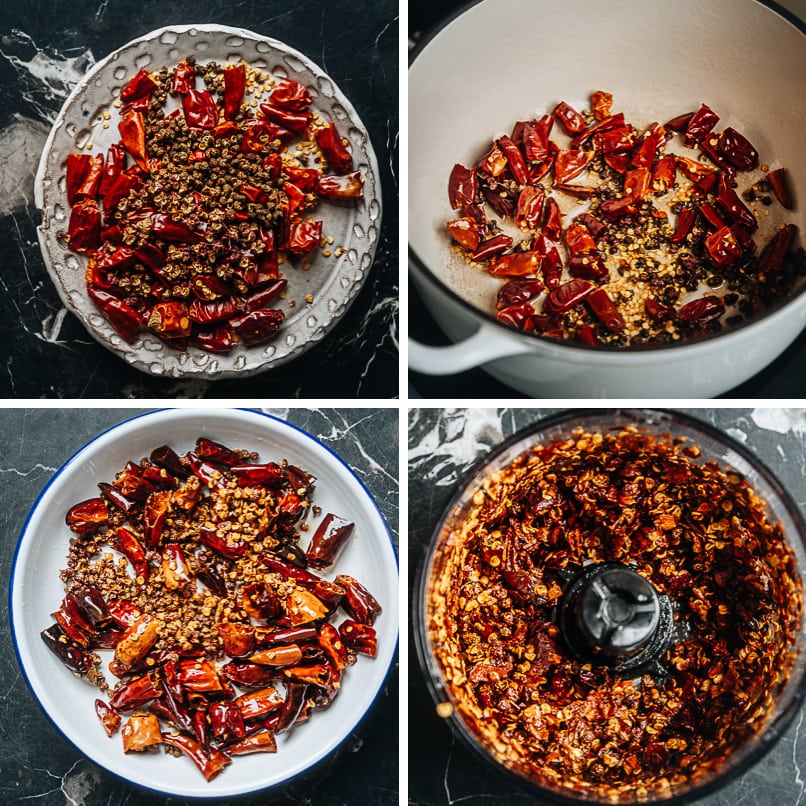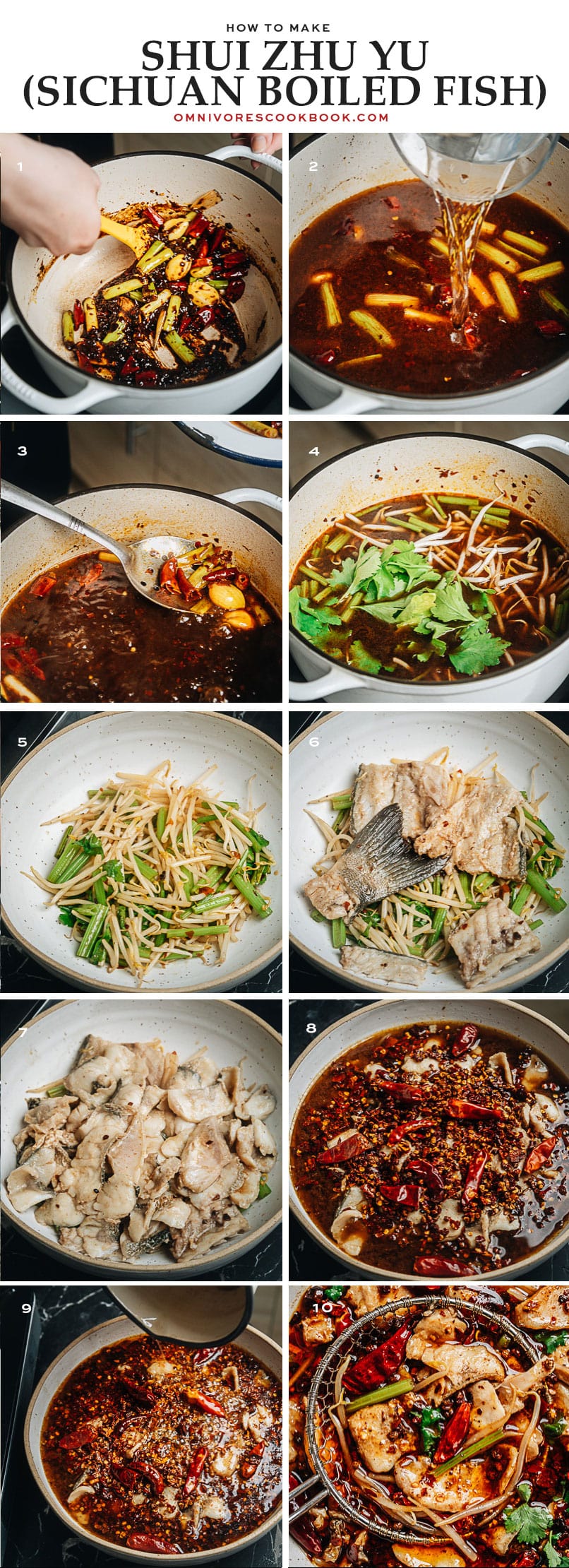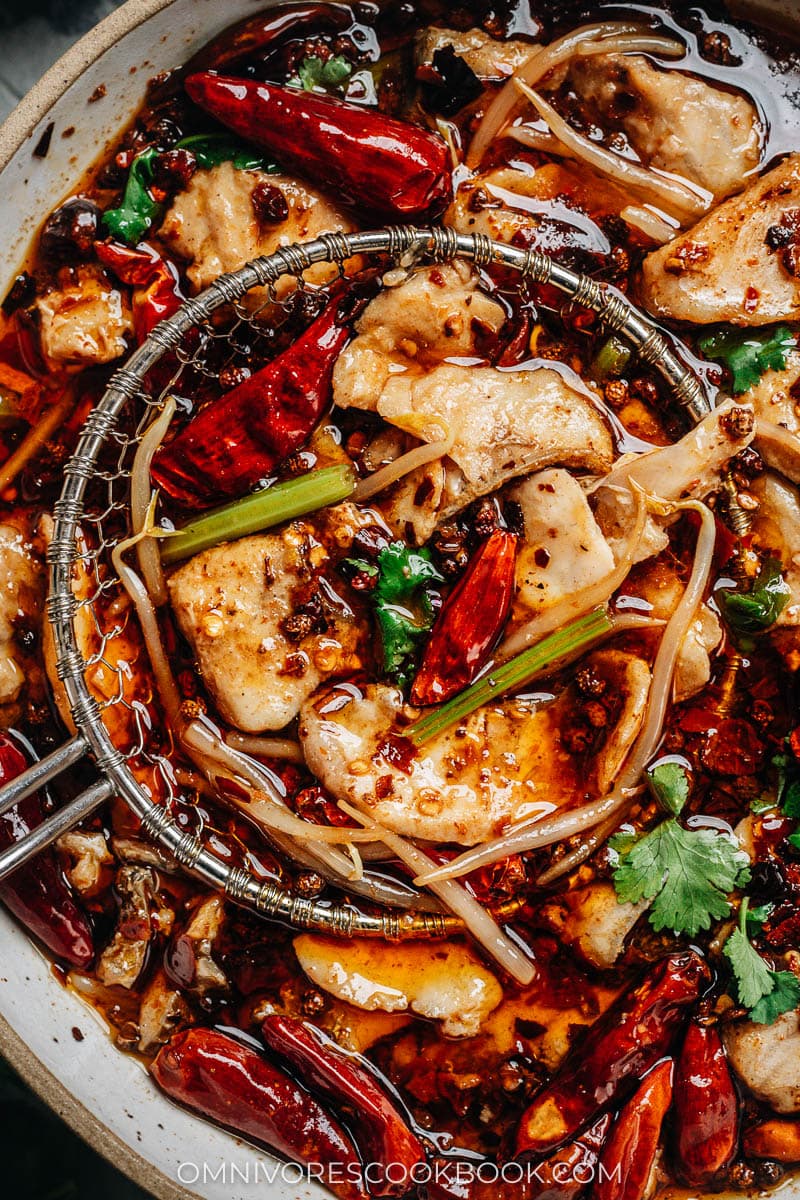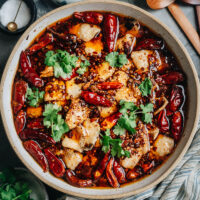There are a few dishes I’ve truly missed after moving from China to the US. Shui Zhu Yu, or Sichuan boiled fish, is one of them. Not only is this dish addictively tasty, but it also represents friendship, gathering, and celebration. It’s one of those must-have dishes when I hang out with friends and family when we want something slightly fancy. I remember when a friend of mine came back from Japan, we went all out by ordering boiled whole fish, dan dan noodles, chicken in red oil, and stir fried pea shoots. It was just two of us girls and we finished it all. And she kept telling me how much she missed the food. Now I can relate.
What is Shui Zhu Yu
Shui Zhu Yu, translated literally, means “water boiled fish”, which sounds bland and does not represent the dish at all. The dish is the opposite of the typical idea of “boiled” you might have in mind. It uses bowls of dried chili peppers, Sichuan peppercorn, and doubanjiang to create a rich, savory, spicy, and intense aromatic broth. The fish is very thinly sliced, marinated, and cooked briefly in the broth until tender and juicy. It is then finished up by pouring hot oil over the fish and the broth. The boiling oil will further cook the spices to release more fragrance. Every bite of fish will be thinly coated with the sauce and fragrant oil, giving it the most satisfying sensation. The dish is usually served in a giant bowl with a bed of vegetables hidden under the fish. The veggies are so nicely seasoned that they’re just as good as the fish. At the restaurant, you can choose either the cheapest fish – carp – or a fancier fish such as catfish, bass, or snapper, but they’re all live fish. Once you pick a fish, the chef will bring the fish in a net to show you that it’s alive, before it heads to the kitchen.
Making Shui Zhu Yu at home
Before moving out of China, Shui Zhu Yu was one of the dishes I never would have imagined cooking at home. But after many disappointing renditions of it at restaurants in the US, even at some of my favorite Sichuan restaurants, I decided it was time to develop a recipe. The dish is not a cheap one in China, and it’s even more expensive in the US. Here the portions are usually small, the fish not as fresh, and the spices not as fierce. Once I started looking into the recipe, I surprisingly found that it’s actually very possible to recreate the restaurant version from back in China. This is by no means an easy recipe. But if you’re a serious cook and would like to get your hands on the very authentic Sichuan dish, this is the one for you.
The ingredients & spices
Whole fish vs. fish fillet
For me, you have to use a very fresh (live if possible) whole fish to make the dish, otherwise it won’t be quite right. When using a fresh whole fish, you can slice the fillets extra thin without them falling apart after cooking. Because the fish flesh will be slightly firmer and the fish skin will hold the pieces together. And it will taste richer. The fish will also have a slightly springy texture that a frozen piece of fish no longer has. When you use a whole fish, you will use the fish bones and fish head in the broth, further adding layers of flavor to the dish. All that said, you can totally use frozen fillets in the recipe below, if a whole fish is nowhere to be found. We’ve developed the recipe in a way that you will end up with a great meal no matter what cut of fish you use.
What fish to use
Many types of white fish will work in this dish, but I personally prefer a slightly oily fish for a more satisfying texture. Back in China, my favorite fish to order was catfish. Because it is affordable and has very rich flesh. However, it’s hard to find a smaller sized catfish in the US. We ended up using branzino and I was very happy with the result. Alternatively, you can also use sea bass, snapper, flounder, and other types of white fish, as long as it has a firm texture. Avoid cod because it will fall apart during cooking.
Doubanjiang
Doubanjiang, or fermented spicy broad bean paste, is the foundation of the dish and adds saltiness and fermented umami. It’s the key ingredient in many Sichuan dishes such as mapo tofu and twice cooked pork. You should have this one in your pantry if you love Sichuan food.
Chinese chili peppers
Authentic Shui Zhu Yu uses tons of dried chili peppers, to add aroma, spiciness, and the stunning appearance (In China, you will find the bowl contains more chili pepper than fish). The type of dried chilis used here are not super spicy, so the dish won’t taste intolerably hot. You can find some of the best peppers at The Mala Market. I like to use a combination of Facing Heaven Peppers and Lantern Peppers. Both are medium spicy, and the latter imparts a nice smokiness to the dish. If you cannot find Chinese chili peppers, the Korean chili peppers will work as well, since they have a similar spice level. Avoid Thai bird’s eye chili peppers because they are too spicy.
Sichuan peppercorns – red and green peppers
Sichuan peppercorns are the main ingredient in this dish to create that numbing tingling sensation. Authentic Shui Zhu Yu uses both the red and green peppercorns. Both have slightly different tones – one is a bit warmer and the other is grassier. Because they lose potency quite fast and the fresh ones make such a difference, you should use the highest quality product you can find. I highly recommend the red Sichuan peppers and green Sichuan peppers from The Mala Market. If you have green pepper oil, you can skip the green peppercorn and drizzle 1 teaspoon at the end of cooking to further boost the dish. On the other hand, if you do not have the green peppers, you can skip it and use the red ones instead.
One word on mushroom powder
Since most Chinese restaurants will use MSG in the dish, we decided to add mushroom powder (or you can use chicken bouillon powder) to give the dish an extra kick so it’s astonishingly close to the restaurant version. You can totally skip it as well.
Cooking process
Butcher the fish
As I mentioned above, it’s best to use a whole fish. And here is how to butcher it. But you can skip this step as well, if you plan to use fish fillets. The advantage of using a whole fish is that you can use the bones and the head to create an extra rich broth.
Prepare the topping
Cook the dish
Traditionally, the fish head and fish bones will be in the same serving bowl. Because (1) we usually pick the fish meat from the bones and eat it, (2) so you know the restaurant actually used the whole fish. If you’re hosting a dinner party with a mixed audience, you might want to remove the bones and the fish head from the final presentation. The cooking might look a bit complicated, but it’s actually quite simple once you try it. The key is to cook the ingredients separately and take them out as soon as they are cooked, so you will have a layered bowl just like the restaurant version, and nothing is overcooked.
How to serve Shui Zhu Yu
Serve Shui Zhu Yu in a big serving bowl as the centerpiece of your table. Don’t forget to prepare a slotted spoon for the bowl and smaller plates for each guest, so you can fish out the food from the spicy broth. NOTE: Do not eat larger pieces of dried chili peppers or the whole pieces of Sichuan peppercorn. You will need to pick them out as you eat, and that is part of the experience. What we usually do in China is place a spoonful of fish and veggies onto your smaller dish, pick out the dried spices, let the oil drain slightly, then eat the fish and veggies with steamed rice.
Final thoughts
Shui Zhu Yu is not an easy dish to make. But in my opinion it’s worth every effort because it’s so much cheaper than ordering it in a restaurant. And Chances are, this homemade version will taste better. No matter you’re celebrating Chinese New Year or hosting a dinner party, this dish can be the centerpiece of your table. In the past, I’ve shared a Shui Zhu Rou recipe (Sichuan Boiled Beef), which is a bit less popular than the fish version but quite delicious as well. The method in that recipe is a lot easier, if you’re looking for a shortcut. On the other hand, use this recipe if you want the full-on Sichuan experience and when you have a bit of extra time on hand. Lilja Walter is a part of the Omnivore’s Cookbook team and worked closely with Maggie to develop and test this recipe.

